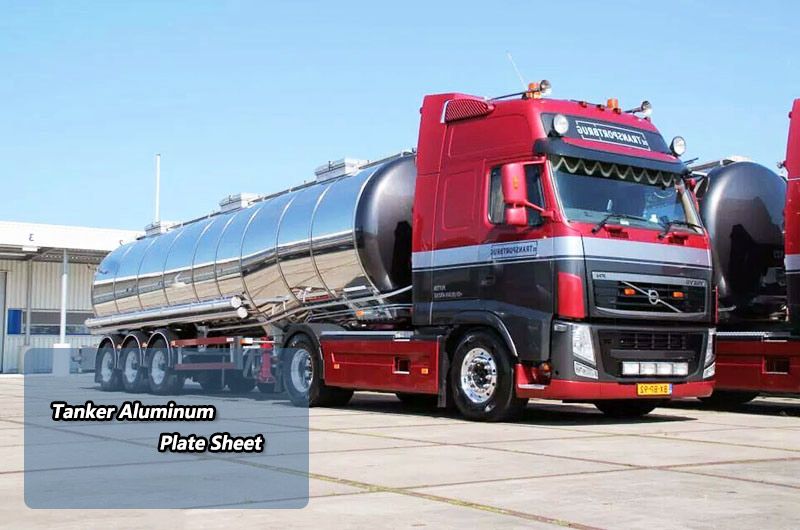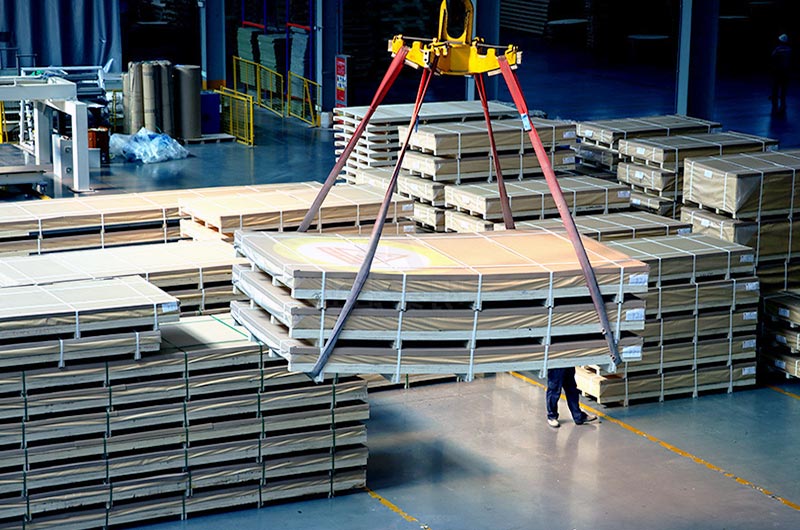- Properties of Tanker Aluminum Plates
- Introduction to Aluminum for Tanker
- Applications of Tanker Aluminum Plates:
- Manufacturing Processes of Tanker Aluminum Plates:
- People also search about Tanker Aluminum
- People also ask about Tanker Aluminum
- Conclusion
Properties of Tanker Aluminum Plates
1. Corrosion Resistance
Tanker aluminum plates are renowned for their exceptional corrosion resistance. This property is essential for materials that come into contact with liquids, particularly those that might be corrosive.
The aluminum surface forms a protective oxide layer that prevents corrosion, enhancing the longevity of the tanker.
2. Lightweight and High Strength
One of the primary advantages of using aluminum in tanker plates is its lightweight nature combined with high strength. The lightweight property contributes to fuel efficiency, allowing tanker vehicles to transport larger quantities without compromising on safety.
The high strength ensures that the plates can withstand the stress and pressure exerted during transportation.
3. Thermal Conductivity
Tanker aluminum plates exhibit excellent thermal conductivity. This property is significant when transporting liquids at varying temperatures.
The efficient heat transfer capabilities of aluminum help in maintaining the desired temperature of the cargo, whether it is a hot liquid or a cryogenic substance.
4. Formability and Weldability
Aluminum is known for its formability and weldability. Tanker aluminum plates can be easily shaped and welded, allowing manufacturers to create customized designs that meet the specific requirements of different tanker configurations.
This flexibility is crucial for designing efficient and safe tanker structures.

Introduction to Aluminum for Tanker
Aluminum is commonly used in various parts of tanker construction due to its specific properties, such as lightweight, corrosion resistance, and formability. The choice of alloy depends on the requirements of the specific application. Here are some common parts of a tanker where aluminum is used, along with the typical alloys and the reasons for their use:
Aluminum Plate Sheet for Tank Body
Alloy Used: 5xxx series alloys (e.g., 5083, 5454)
Reason: These alloys offer a good balance of strength, corrosion resistance, and formability. The tank body needs to withstand the internal pressure of the transported liquids and resist corrosion from the contents, making alloys like 5083 and 5454 suitable choices.
Aluminum Plate Sheet for Tanker Shell
Alloy Used: 6xxx series alloys (e.g., 6061, 6063)
Reason: 6xxx series alloys are known for their excellent formability, making them suitable for the curved and shaped sections of the tanker shell. Additionally, these alloys provide good corrosion resistance and are weldable, allowing for the fabrication of complex structures.
Aluminum for Tanker Frame and Supports
Alloy Used: 6xxx series alloys (e.g., 6061, 6082)
Reason: The frame and support structures of the tanker require a combination of strength and weldability. 6xxx series alloys offer the necessary strength to support the tanker's weight and the flexibility to be welded into the desired shapes.
Aluminum Plate Sheet for Baffles and Internal Structures
Alloy Used: 5xxx series alloys (e.g., 5083, 5052)
Reason: Internal components like baffles and structures need to be lightweight yet durable. Alloys like 5083 and 5052 provide the required strength while remaining lightweight, contributing to the overall efficiency of the tanker.
Aluminum Plate Sheet for Tanker Ends and Domes
Alloy Used: 5xxx series alloys (e.g., 5083, 5086)
Reason: The ends and domes of the tanker are subjected to stress and pressure, and 5xxx series alloys, known for their high strength and corrosion resistance, are chosen to ensure structural integrity under these conditions.

Piping and Fittings
Alloy Used: 6xxx series alloys (e.g., 6061, 6063)
Reason: Piping and fittings require materials that are easy to shape and weld. 6xxx series alloys provide the necessary formability and weldability for the fabrication of intricate piping systems.
Accessories and Ladders
Alloy Used: 6xxx series alloys (e.g., 6061)
Reason: Accessories like ladders and handrails benefit from the combination of strength and formability offered by 6xxx series alloys. Alloy 6061, in particular, is widely used for its balance of properties.
Tanker Chassis and Undercarriage
Alloy Used: 7xxx series alloys (e.g., 7075)
Reason: In some tankers, especially those requiring high strength and durability, 7xxx series alloys like 7075 might be used in the chassis and undercarriage components. These alloys provide exceptional strength-to-weight ratios.
It's important to note that the choice of alloy is influenced by factors such as the type of cargo being transported, the structural requirements of the tanker, and cost considerations. Additionally, ongoing advancements in materials science may lead to the development and adoption of new aluminum alloys with enhanced properties for specific tanker applications.
Applications of Tanker Aluminum Plates:
1. Oil and Gas Industry
Tanker aluminum plates find extensive use in the oil and gas industry for transporting crude oil, refined products, and various chemicals. The corrosion resistance of aluminum is particularly valuable in this context, given the nature of the substances being transported.
Alloy: 5083 or 5454 aluminum alloy.
Why: These alloys offer a good combination of strength, corrosion resistance, and weldability. They are well-suited for the transportation of crude oil and refined products.
2. Chemical Transportation
Aluminum tanker plates are also employed in the transportation of various chemicals. The resistance to corrosion ensures that the plates remain structurally sound, maintaining the integrity of the tanker and preventing leaks or contamination.
Alloy: 5083 or 6061 aluminum alloy.
Why: These alloys provide excellent corrosion resistance, which is crucial when transporting a variety of chemicals. Additionally, 6061 offers good strength and weldability.
3. Food and Beverage Industry
Tanker vehicles used for transporting food-grade liquids often utilize aluminum plates. The corrosion resistance, coupled with the ease of cleaning and maintaining hygiene, makes aluminum an ideal choice for this application.
Alloy: 3003 aluminum alloy.
Why: 3003 is known for its excellent corrosion resistance and is considered food-safe. It is also easy to clean and maintain hygiene standards.
4. Cryogenic Transport
In industries dealing with cryogenic substances such as liquid nitrogen or liquefied natural gas (LNG), aluminum tanker plates play a vital role. The high thermal conductivity of aluminum aids in maintaining the low temperatures required for these substances.
Alloy: 5083 or 6061 aluminum alloy.
Why: These alloys provide good thermal conductivity, which is essential for maintaining the low temperatures required for transporting cryogenic substances like liquid nitrogen or LNG.
5. Water and Wastewater Transport
Tanker aluminum plates are also used in the transportation of water and wastewater. The corrosion resistance ensures that the plates do not degrade over time, maintaining the structural integrity of the tanker and preventing contamination of the transported liquids.
Alloy: 5052 or 6061 aluminum alloy.
Why: These alloys offer good corrosion resistance, making them suitable for transporting water and wastewater without the risk of degradation over time.
It's important to note that the specific alloy chosen can vary based on the manufacturer's preferences, cost considerations, and the exact requirements of the intended application.
Additionally, factors such as plate thickness and the overall design of the tank truck also play a role in ensuring the structural integrity and performance of the tanker.

Manufacturing Processes of Tanker Aluminum Plates:
Aluminum Alloy Selection
The manufacturing process begins with the selection of the appropriate aluminum alloy. Common choices include 5xxx and 6xxx series alloys, known for their balance of strength, formability, and corrosion resistance.
Hot Rolling
The selected aluminum alloy is subjected to hot rolling, a process that reduces the thickness of the metal while increasing its length. Hot rolling imparts the desired mechanical properties to the aluminum, enhancing its strength and formability.
Cold Rolling
Cold rolling follows hot rolling and involves further reducing the thickness of the aluminum at room temperature. This process refines the surface finish and improves the dimensional accuracy of the plates.
Heat Treatment
Heat treatment is employed to optimize the mechanical properties of the aluminum. This step enhances the strength and toughness of the material, ensuring it meets the stringent requirements for tanker applications.
Surface Treatment
The surface of the tanker aluminum plates undergoes treatment to enhance corrosion resistance. This often involves applying protective coatings or anodizing the surface to form a durable oxide layer.
Cutting and Shaping
The final step involves cutting the aluminum sheets into the desired sizes and shapes for constructing the tanker. Precision cutting technologies ensure that the plates can be seamlessly integrated into the tanker's design.
People also search about Tanker Aluminum
- tanker aluminum trailer
- oval shaped aluminum tanker truck
- aluminum tanker fenders
- aluminum tanker trailer fenders
- aluminum tanker
- aluminum oil tanker trailer
- polishing aluminum tanker trailer
People also ask about Tanker Aluminum
- What grade of aluminum is used for fuel tanks?
- What are tanker trailers made of?
- What do tanker trucks carry?
- How much weight can a tanker truck carry?
Conclusion
Tanker aluminum plates are indispensable components in the transportation of liquids and gases, offering a unique combination of properties that ensure safety, efficiency, and durability.
As technology continues to advance, we can expect further innovations in materials and manufacturing processes, contributing to the continual improvement of tanker plate performance.
The intersection of materials science, engineering, and industry demands will shape the future of tanker aluminum plates, playing a vital role in the evolution of liquid and gas transport systems worldwide.
